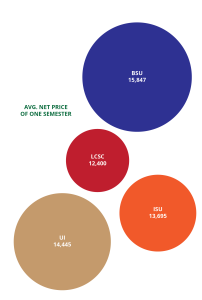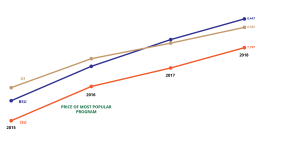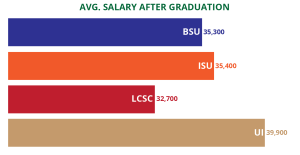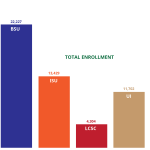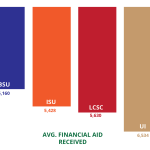Increasing tuition and fees creates a heavy financial burden on students
Tuition is on students’ minds. It is a check that seems to grow with each passing year, even if the 3.5 percent increase in 2015 was the smallest increase in 15 years, according to the Idaho State Board of Education’s (SBOE) Chief of Communications and Legislative Affairs Officer Blake Youde.
According to the University of Idaho website, a full-time Idaho resident obtaining their undergraduate degree, tuition and fees alone in 2015 is $3,510 per semester at UI. A non-resident’s tuition and fees is $10,512 per semester this year. This doesn’t include art and architecture students, who pay $4,063 per semester or law students, who pay $8,615 per semester.
Using estimates for how much tuition will continue to increase, the National Center for Education Statistics (NCES) approximates tuition at UI to be $4,183 per semester in 2018 — an additional $670 increase.
“College is becoming unaffordable,” said assistant clinical professor of economics Steven Peterson.
Peterson calculated the cost of tuition based purely on the inflation rate from 1980 to 2014. In 1980, the university’s tuition and fees were $295 per semester. Peterson calculated that without any tuition increases in addition to inflation, students would now be paying $848 per semester.
“It’s getting more difficult for students to go to school,” Peterson said.
According to the U.S. Department of Education’s College Scorecard, UI has the second highest average annual cost for schooling in the state, behind Boise State University by about $1,000. However, UI graduates generally have larger salaries than their BSU counterparts.
UI President Chuck Staben said the tuition increase was in part due to the Idaho legislature giving a 3 percent raise to all state employees. Staben said at UI, with several of the faculty and staff not being state-funded, it didn’t seem fair for universities to let only part of their staff receive raises.
Staben said the heads of universities wanted to ensure the quality of education at their institutions, the best faculty to teach their students and to maintain competitive salaries that are in step with the state. Staben said about 75 percent of students’ tuition and fees go toward salaries and benefits of faculty and staff.
The state funding for higher education in the last few years has decreased, Youde said. State funding has to be shared across all areas, including higher education, and it is a competition to gain priority.
Currently, K-12 public education has the highest priority, followed by health and human services, public safety and then colleges and universities, Youde said. Altogether, the top four priorities make up 62 percent of the state budget.
Youde said since state funding has been decreasing, the burden of education on students is heavier than it has been in the past. In the 2005 fiscal year, students alone had to carry 30 percent of their college costs. In the current fiscal year, students are shouldering 47 percent of the costs.
“It is a bigger burden,” Youde said. “Costs have increased for higher education and students have had to bear that burden.”
Staben said there are three different areas students receive money from: scholarships, loans and other financial aid, plus the money that the students provide themselves. Since state funding has gone down for college education, the amount that students are personally providing has gone up, which is why students are seeing and feeling the pressure, Staben said.
Youde said the SBOE is aware of the pressure that raising tuition is putting on students and it is a concern which will likely be discussed in April. Youde said SBOE is trying to take steps to limit the cost of college and to still maintain the high quality of education.
“Nobody is discounting tuition and fees,” Youde said. “The cost of education can bring pressure to students … Education really impacts a student’s entire life, both intellectually and financially.”
Staben said that while a 3.5 percent increase is not tiny, it is a pretty small increase compared to previous years. As tuition and the cost of college goes up, so do loans, Staben said. UI graduates normally graduate with approximately $25,000 in loan debt, but Staben said it is worth the investment.
“It is a sign
ficant burden, but it is a great investment,” Staben said.
There is help available for students who are considering dropping out for a semester to raise money to continue their college education, Staben said. He said taking a break to gain money is almost always a bad decision. It is more important for students to graduate as soon as possible and start their career, he said.
“It will be the best $25,000 investment you will ever make,” Staben said. “It is good for individuals and for society.”
The burden of tuition is also being spread over a smaller number of students, Staben said. According to the NCES statistics, which are based on 2014-2015 numbers, UI has 9,283 undergraduates. BSU has 19,333 undergraduates and ISU has 11,517. In order to increase tuition by a total of 3 percent, a smaller population will pay more than a larger population, Staben said.
Peterson said between 2003 and 2013, UI’s student body shrank 7.8 percent while BSU’s grew by 19.3 percent over the same 10-year period. Peterson attributes this decrease to the increased cost of attending school at a resident campus like UI, especially with the tuition increase.
Peterson has been keeping track of the raising tuition for nearly 30 years. He said UI should implement more scholarship programs and bring back the Western Undergraduate Exchange to help increase the student population and therefore alleviate some of the financial pressure. Peterson and Staben both said they want the state funding to increase so the amount of money students have to provide is smaller.
“Students need to make legislature more aware of the burden,” Peterson said. “This needs to be a serious issue.”


